 Are you the type of evil ne’er do-well that just wants to be left alone to plan your nefarious deeds? Are you sick of rampaging adventurers breaking into your lair and thrashing the place? Do you want to build the perfect hideaway, far from those awful villagers? If so, Dungeon Lords may be the game for you. Is building and protecting your evil sanctum in Dungeon Lords as fun as it sounds? Keep delving to find out!
Are you the type of evil ne’er do-well that just wants to be left alone to plan your nefarious deeds? Are you sick of rampaging adventurers breaking into your lair and thrashing the place? Do you want to build the perfect hideaway, far from those awful villagers? If so, Dungeon Lords may be the game for you. Is building and protecting your evil sanctum in Dungeon Lords as fun as it sounds? Keep delving to find out!
Dungeon Lords is a strategy game for 2-4 players that plays in about 90 minutes. Dungeon Lords plays best with 4 players.
Game Overview:
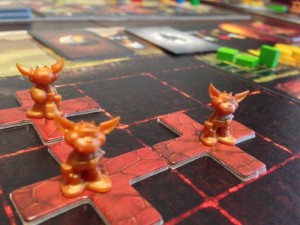
Dungeon Lords puts you in charge of creating the very best dungeon you can in preparation for those nasty good guys who inevitably show up to kick down your door and spoil your fun. Each player becomes an evil mastermind who must recruit goblin workers, mine for gold, build tunnels and traps, hire monsters, and manage their dungeons over the course of a year. They must do this all while monitoring and altering their “evilness” to determine the power level of the adventurers that will come to loot their dungeon. At the end of the year, the good guys attack with their success or failure depending on how you deploy the monsters you’ve hired, where you’ve set up your traps, and how you’ve constructed your dungeon.
In the second year, you have to clean up the damage that from the adventurers and then restock and rearm for another year before a more powerful party shows up and tries to break in. After two years of game time, players are awarded points for the unconquered rooms in their dungeon, the monsters they have hired and adventurers they have captured, while losing points for conquered rooms and accruing debt. In addition, points are earned for having more of a particular resource than your opponents. At the end of the game, the player with the most points wins!
Components:
The components in Dungeon Lords are of the standard high quality one would expect from a game produced by CGE. The central boards and player boards are thick and high quality, as are all the cardboard chits. The minion worker tokens are wooden and durable like any good worker placement game should be, as well as the tokens for food and gold. An interesting choice was to make the imp tokens out of molded plastic. While done ostensibly to add more detail and theme to the game (and to avoid a common Euro trope of pushing cubes around a board), the problem is that the color of the plastic makes me feel like I’m moving around partially melted caramels rather than imps. Silly, I know, but it’s something I haven’t been able to shake. (Especially since my wife pretends to eat them.)
Two qualities that need to be highlighted are the artwork and the rulebook, which are nothing short of extraordinary. The art on the central board and player boards is breathtaking, with little details and humorous touches added in every nook and cranny. When you pick this game up, take the time to check out all the boards carefully. At the same time, the rulebook is masterfully written, with the rules describing the second phase first, so new players know what they will have to prepare for. In addition, practice scenarios are provided so players can get acclimated quickly to the game system. The rulebook itself is filled with humor, and is one of the few rules texts that actually adds to the theme of the game.
How to Play:
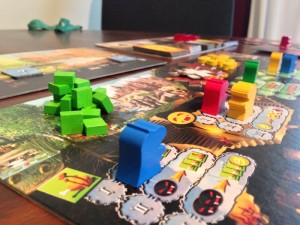
Each of the two years is divided into two phases, Building and Combat. The Building phase lasts four seasons, during which a series of steps occur (which are helped to be tracked by a well-designed progress board). At the beginning of each season, a forecast reveals the adventurers to be prepare for (more on this later), the monsters for hire, the rooms available for purchase and the upcoming special event.
Next comes the heart of the game, where you send your three minion workers out to perform actions, which include recruiting imps, hiring monsters, improving your reputation, getting gold and food, and buying and building rooms, tunnels and traps. All players place their workers by secretly selecting three actions, then revealing them one at a time. The catch is that two of the actions selected in the previous turn are locked and unavailable for the current turn, which requires you to plan out your moves ahead of time. Once all the actions are revealed and the minions are placed, it becomes time to execute the actions. The trick here is that each action space has three possible outcomes, depending on what order you and your opponents choose that action space.
For example, when selecting the “Get Food” action, the first player who placed a worker there trades a gold for two food, the second player loses a reputation point for three food, and the third player loses two reputation points for four food (which is all explained very thematically and humorously in the rulebook). Having different outcomes for each action space depending on when you play your minion forces you to pay close attention to the actions (both locked and unlocked) of the other players. This is to help you predict whether or not they will be attempting to take the same action as you, and which specific outcome you will get if you choose an action.
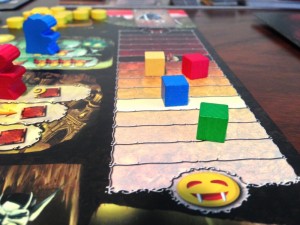
A key component of the game that needs to be mentioned here is reputation and the importance of managing it. Your reputation can go up or down, based on actions you have taken. For instance, hiring a Vampire for your dungeon or attacking the village for food causes your reputation to go down, but choosing the reputation action causes it to go up. It is important to keep an eye on your reputation for two reasons: it determines the strength of the adventurers that come to your dungeon, and if you become too evil, you draw the attention of the Paladin. The Paladin is a super-adventurer who is extremely tough to defeat. Having the forecast of which adventurers are coming allows you to manage your reputation track and plan your actions to attract the adventurer that will be most easily defeated by the dungeon you have built.
After the workers have been placed and actions have been executed, you get to use imps and your rooms to gain additional resources, such as using three imps to gain an extra food token. A special event then occurs, such as having to pay gold for the number of tunnels you have or having to pay your monsters you’ve hired. At this point, the adventurers are distributed one to each player, based on their position on the reputation track, with the stronger adventurers going to the players with the most evil reputation.
That sums up one cycle of the Building Phase. Each year has four cycles (corresponding to seasons in the year) before the adventurers feel they have gathered a large enough party, at which point they descend into your dungeon and attack! This begins the Combat phase, which also lasts four rounds. The goal of Combat is to defeat the adventurers by playing cards that add wounds to the party, either through the use of traps or monsters. The goal is to defeat all the adventurers as quickly as possible (preferably in a single round, although this can be difficult) to prevent them from delving too deeply into your dungeon and destroying what you have built.
The mechanic regarding combat is that the party is in a specific marching order, and cards deal damage and have effects based on where an adventurer is in the party. For instance, the Witch can deal 4 damage to the first adventurer in line, or 1 damage to two adventurers anywhere in line, while the Slime deals one damage to each party member. Traps function the same way, identifying the position of the adventurer they affect and the effects and amount of damage they do. Planning out how you are going to take out the party is tricky, as you have to keep in mind the special abilities of the adventurers. Priests heal wounds, rogues ignore trap damage, and wizards can cast spells (which are random variable effects in the middle of each round). Combat is essentially a logic puzzle to determine what is the most effective means of combining your monsters and traps and in what order to eliminate the party as quickly as possible. If you’re able to do that, great! If not, it’s a good thing Combat only lasts 4 rounds, because at that point, the adventurers get bored and leave.
After combat, the Building phase begins again, only this time with stronger monsters, better traps and more powerful adventurers. The Building phase goes through the four season cycle, then Combat occurs again, which is even more difficult because of the tougher adventurers. After the second round of combat, the scores are totaled and whoever has the highest score is declared the winner.
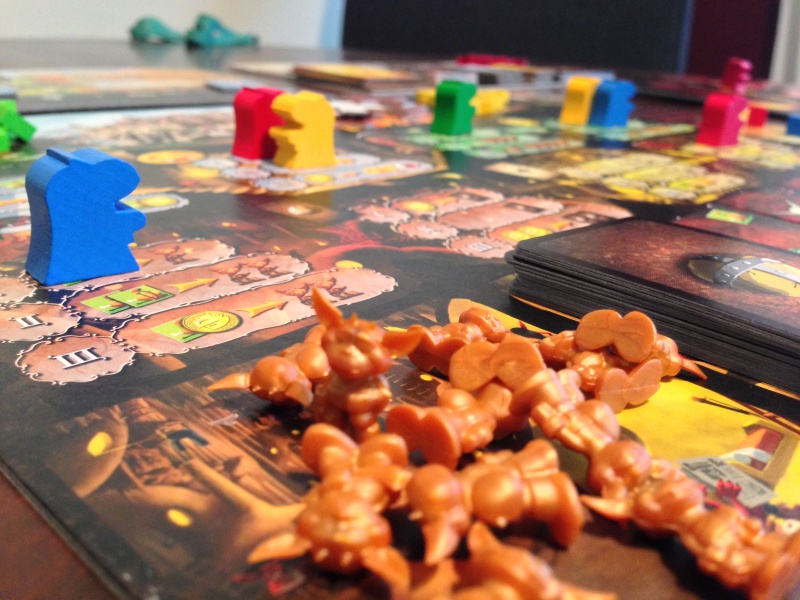
Game Experience:
There is no denying that Dungeon Lords is a game that has a fair bit of depth in terms of complexity and strategy. The combined mechanic of action programming and worker placement is an elegant one, and really challenges the players to have a plan based on the circumstances the game presents (adventurers, resources available, etc.) Unfortunately, this level of complexity can lead to some frustration for newcomers, as one poorly timed action or one missed opportunity can sink your well-crafted plan.
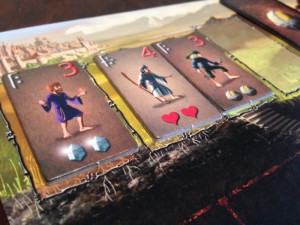
The need to not only keep an eye on your own needs and resources, but what your opponents are doing as well, cannot be stressed enough. The “second player” position on each action space is usually the best in terms of effect and economy, so being strategic in your action selections to be in that “second position” is a solid play. Recognizing what actions your opponents have locked out and are not playing that turn adds to that as well. Additionally, it is vital to continually monitor your position on the reputation track and use the adventurers forecast to plan out your moves; if you are going to end up attracting a rogue, it’s pointless to spend time building traps. Appearing complicated at first blush, the action selection mechanic is an easy one to pick up and an enjoyable one as you get the hang of the game.
One of the most enjoyable parts of the game are the two distinct phases, and being able to identify and take advantage of the connections between Building and Combat. Like Galaxy Trucker, another of Vlaada Chvatil’s games, the two phases seem disconnected on the surface, but having success in the later phase is directly dependent on the beginning phase. Recognizing the connections between the phases and getting the overall strategy of the game down makes it one of the more satisfying “heavy” games to play, in that there’s a real sense of satisfaction and achievement when the rules and gameplay finally click together and start making sense.
The puzzle of determining how you are going to conquer the adventuring intruders is highly appealing to me. Dealing with the adventurers is the payoff for all the hard work that was done during the planning phase, and is when you get to see whether or not your planning and preparation were effective. There’s not much more satisfying in this game than being able to wipe out the adventurers in one round, which I’ve been fortunate to have happen once or twice in my own plays. On the other hand, there’s a certain enjoyment for me to having everything go wrong in your dungeon, and have the pesky do-gooders wreck your house. Sometimes, you’ve got to laugh at just how badly you’ve miscalculated.
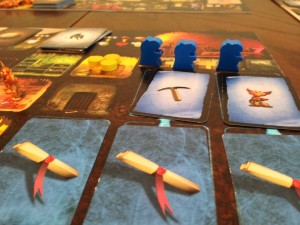
I can’t mention enough how much I love the theme of this game. As you’re selecting actions, building your dungeon and defending it from the adventurers, you have little-to-no choice but to become immersed in the storyline that develops as you play the game. There’s drama as the adventurers are revealed in the forecast, and a mad scramble for resources to best deal with the oncoming threat. During Combat, the moment when the Spell cards are revealed (a variable effect that changes each game) can spell certain doom for your well-crafted machine, and the combat mechanics have a certain drama to them as well. You can’t help but be absorbed by the theme, and it’s probably one of the most thematic games I’ve played.
One last note: Usually gamers tend to overlook training scenarios in favor of jumping right into a game. Do NOT attempt this with Dungeon Lords. The training scenarios provided in the rulebook, while being hysterical to read, give you a great experience with Combat, so you understand the goals you should have when you are constructing your dungeon. Take the time to read the rulebook; this is no poorly written document, but rather a relatively easy read that will not only immerse you in the theme, but give you a good understanding of the rules. I am a fan of reading rulebooks, but this game’s rules are such that I’ve actually gone back and reread them a number of times because I find them so humorous and enjoyable to peruse.
Final Thoughts:
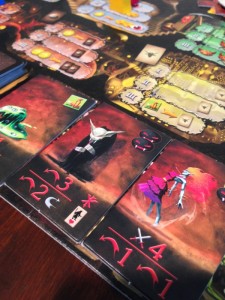
I’m a fan of Dungeon Lords. I like the mechanics used to create the dungeon, and the logic and planning required to take down the adventurers really hits my sweet spot for games. The theme is very immersive and will speak to anyone who has any experience with RPGs, be it tabletop or video game-based. It’ll be great for anyone who enjoys deeper-than-average Euro-style worker placement games. That said, this is a game not to be played with someone who is prone to analysis paralysis, as they can sit there for eons trying to plan out their turn. Also be forewarned that this is not a casual filler game to be played on a night when your DM doesn’t show up – this will require a good amount of instruction on game play, and odds are inexperienced players may not enjoy it the first time around because they are trying to get a handle on what is a complicated game.
While Dungeon Lords can play with two to four players, the game best plays with a full complement of four. The reason why is because with any less players, the players are required to act as a “dummy player” in addition to their own, and select actions that get blocked off. This adds even more complexity to the 2-3 player version, which is eliminated by having a full 4 players. Having had experience with all of these variations, gathering up 4 players is worth the time and effort for the experience it gives you.
The complexity and heaviness of the game may be a turn-off to some, but if you can handle some depth in your board games, and are ready to get thrown into a game with a great theme that shines through in all phases of the game, then you should pick up a copy of Dungeon Lords.
If you are interested in getting a copy for yourself, it’s about $46
Final Score: 4 Stars – Good game, but it’ll take a few plays with your group to get them up to speed with it.
 Hits:
Hits:
• The theme is so immersing, you can’t help but get excited about playing
• Good mechanics in both phases of the game
• Artwork and components are top-notch
Misses:
• Easy for first-time players to get confused and overwhelmed
• Playing with less than four players is actually more complicated





















I recently tried this game for the first time about a week ago. I’m still unsure about it. I’ll give it another try, but the first play through left a bad taste in my mouth. The strategy of the game is so convoluted and deep that it’s not easy to pick up even a working survival strategy from an initial play. If it takes me 3-4 games (a number I’ve seen bandied about on BoardGameGeek that I readily believe) just to figure out how to survive a game, that’s a little too deep.
Getting the connections down between the Building and Combat phases is the the most challenging part of the game. That said, I definitely recommend another play, since you probably didn’t have a clue what was going on during your first go-around!
I played this for the first time last night (3 players) and had a great time. Definitely a bit involved for a first-timer but if you’ve got some patient, experienced players to help you out you can get the hang of it pretty quickly.